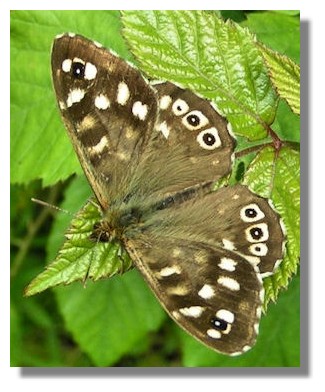
Butterflies of Scotland
- Speckled Wood (Pararge aegeria)

.
The Speckled Wood is found in and on the borders of woodland throughout much of Europe.
Females have brighter and more distinct markings than males. The wingspan of both males and females is 4 - 4.5 cm (1.6 - 1.8 inches), although males tend to be slightly smaller than females. Males are highly territorial and will defend their territory against intruding males. For finding females, there are two basic strategies: Some males will vigorously defend a perch and the immediate surroundings, waiting for females to pass by. Others will patrol a larger territory.
The Speckled Wood is dark brown with creamy white patches on wings. Males have either 3 or 4 upper hindwing eyespots. The fourth spot shows only in flight. It appears that the 4-spotted type tends towards patrolling behaviour to finds mates. This agrees with the probable function of the eyespots to entice predators like birds to aim for the wing margin (which may be damaged without much affecting the butterfly) rather than the body. On the other hand, habitat is apparently a major factor influencing mate-finding strategy: perching behaviour is more common in males of conifer woodland, whereas males of meadows tend towards patrolling behavior.
The Speckled Wood breeds in woodland habitats, lanes and tracks between tall hedgerows parks, gardens, and scrub. It seems to prefer slightly damp areas where there is tall grass and some dappled shade.
The caterpillar is green with a short, forked tail and feeds on various species of grass including False Brome (Brachypodium sylvaticum) Yorkshire-fog (Holcus lanatus) Common Couch (Elytrigia repens) and Cock's-foot (Dactylis glomerata). The chrysalis (pupa) is green or dark brown and can produce a butterfly in a month. However, the species also is unique in its ability to overwinter in two totally separated developmental stages, as pupae or as half-grown larvae. This leads to a complicated pattern of several broods per year, with adults being seen in flight from March to October. Males that hatch in the autumn are darker than those in the spring.
The Speckled Wood flies in partially shaded woodland with dappled sunlight. Both sexes feed on honeydew in the tree tops and are rarely seen feeding on flowers, except early and late in the year when aphid activity is low.
The range of this butterfly contracted during the late nineteenth and early twentieth centuries, but has spread back since the 1920s. It has continued to spread over the past two decades, recolonizing many areas in eastern and northern England. Mainly confined in Scotland to the far west, north-west and Moray. A few colonies have been found also in South-West Scotland in Dumfries & Galloway which may have come from those established in Northern Ireland.
Return to the Butterfly Index
or go to the next Butterfly:Wall Brown.
Where else would you like to go in Scotland?

